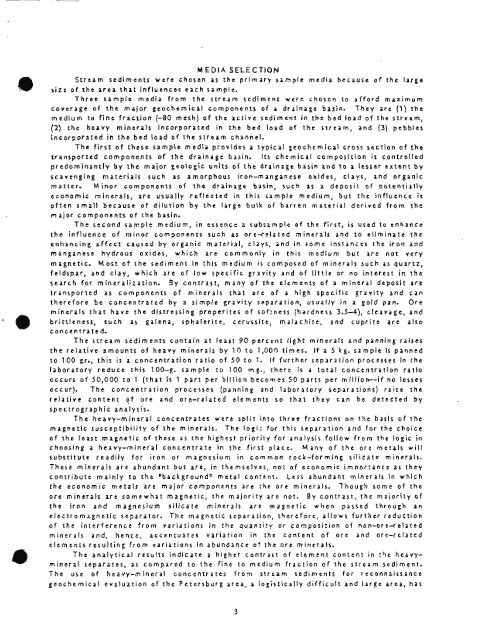mlnerrls library - Alaska Division of Geological & Geophysical Surveys
mlnerrls library - Alaska Division of Geological & Geophysical Surveys
mlnerrls library - Alaska Division of Geological & Geophysical Surveys
Create successful ePaper yourself
Turn your PDF publications into a flip-book with our unique Google optimized e-Paper software.
@<br />
C<br />
M EDlA SELECTION<br />
Stream sediments were chosen as the primary sample media because <strong>of</strong> the large<br />
rite <strong>of</strong> the area that influcncer each sample.<br />
Three sample media from the stream sediment were chosen to afford maximum<br />
coverage <strong>of</strong> the major gcochcmical components <strong>of</strong> a drainage basin. They are (1) the<br />
mtdiurn to fint fraction (-80 mesh) <strong>of</strong> the active sediment in the bed load <strong>of</strong> the stream,<br />
(2) the heavy minerals incorporated in the bed load <strong>of</strong> the stream, and (3) pebbles<br />
incorporated in the bed load <strong>of</strong> the stream channel.<br />
The first <strong>of</strong> these sample media provides a typical geochemical cross section <strong>of</strong> the<br />
transported components <strong>of</strong> the drainage basin. Its chemical composition is controlled<br />
predominantly by the major geologic units <strong>of</strong> the drainage basin and to a Itsser extent by<br />
scavenging materials such as amorphous iron-manganese oxides, clays, and organic<br />
matter. Minor components <strong>of</strong> the drainage basin, such as a deposit <strong>of</strong> potentially<br />
economic minerals, are usually reflected in this sample medium, but the influence is<br />
<strong>of</strong>ten small because <strong>of</strong> dilution by the Iarge bulk <strong>of</strong> barren material derived from the<br />
major components <strong>of</strong> the basin.<br />
The second sample medium, in essence a subsample <strong>of</strong> the first, is used to enhance<br />
the influence <strong>of</strong> minor components such as ore-telated minerals and to eliminate the<br />
enhancing affect caused by organic material, clays, and in some instances the iron and<br />
manganese hydrous oxides, which art commonly in this medium but are not very<br />
magnetic. Most <strong>of</strong> the sediment in this medium is composed <strong>of</strong> minerals such as quartz,<br />
feldspar, and clay, which art <strong>of</strong> low specific gravity and <strong>of</strong> little or no interest in the<br />
search for mineralization. By contrast, many <strong>of</strong> the elements <strong>of</strong> a mineral deposit are<br />
transporfed as components <strong>of</strong> minerals that are <strong>of</strong> a high specific gravity and can<br />
therefore be concentrated by a simple gravity separation, usually in a gold pan. Ore<br />
minerals that have the distressing properitcs <strong>of</strong> s<strong>of</strong>tness (hardness 3.5-4), cleavage, and<br />
brittleness, such as galena, sphalerite, cerurrite, malachite, and cuprite arc also<br />
concentrated.<br />
The stream sediments contain at least 90 percent light minerals and panning raises<br />
the relative amounts <strong>of</strong> heavy minerals by 10 to 1,000 times. If a 5 kg. sample is panned<br />
to 100 gr., this is a concentration ratio <strong>of</strong> 50 to 1. If further separation processes in the<br />
laboratory reduce this 100-g. sample to 100 mg., there is a total concentration ratio<br />
occurs <strong>of</strong> 50,000 to 1 (that is 1 part per billion becomes 50 parts per million-if no losses<br />
occur). The concentration processes (panning and laboratory separations) raise the<br />
relative content <strong>of</strong> ore and ore-related<br />
spectrographic analysis.<br />
elements so that they can be detected by<br />
The heavy-mineral concentrates were split into three fractions on the basis <strong>of</strong> the<br />
magnetic susceptibility <strong>of</strong> the minerals. The logi; for this separation and for the choice<br />
<strong>of</strong> the least magnetic <strong>of</strong> these as the highest priority for analysis follow from the logic in<br />
choosing a heavy-mineral concentrate in the first place. Many <strong>of</strong> the ore metals will<br />
substitute readily for iron or magnesium in common rock-forming silicate minerals.<br />
These minerals are abundant but are, in themselves, not <strong>of</strong> economic importance as they<br />
contribute mainly to the wbackground"metal content. Less abundant minerals in which<br />
the economic metals are major components are the ore minerals. Though some <strong>of</strong> the<br />
ore minerals are somewhat magnetic, the majority are not. By contrast, the majority <strong>of</strong><br />
the iron and magnesium silicate mincrals art magnetic when passed through an<br />
electromagnetic separator. Thc magnetic separation, therefore, allows further reduction<br />
<strong>of</strong> the inttrference from variations in the quantity or composition <strong>of</strong> non-orc+tlated<br />
minerals and, hence, accentuates variation in the conttnt <strong>of</strong> ore and ore-related<br />
elements resulting from variations in abundance <strong>of</strong> the ore minerals.<br />
The analytical results indicate a higher contrast <strong>of</strong> element conttnt in the heavymineral<br />
separates, as compared to the fint to mtdiurn fraction <strong>of</strong> the stream sediment.<br />
The use <strong>of</strong> heavy-mineral concentrates fro-n stream sediments for reconnaissance<br />
geochemical evaluation <strong>of</strong> the Petcrsburg arta, a logistically difficult and large arta, has
















